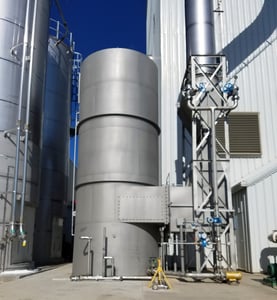Air quality control is important to the success of every business, especially ones with industrial applications. The best way to maintain a high level of air quality is by using dust collection equipment.
 Dust collection equipment improves air quality in your facilities by removing harmful pollutants that can endanger workers, put your regulatory compliance at risk, and damage equipment. Air quality solutions have moved beyond typical dry dust collection, using the inherent properties of the impaction process to create wet scrubbers. Wet scrubbers rely on a scrubbing fluid to remove dust from an air stream. One of the most powerful and widely used type of wet scrubber is the Venturi Scrubber.
Dust collection equipment improves air quality in your facilities by removing harmful pollutants that can endanger workers, put your regulatory compliance at risk, and damage equipment. Air quality solutions have moved beyond typical dry dust collection, using the inherent properties of the impaction process to create wet scrubbers. Wet scrubbers rely on a scrubbing fluid to remove dust from an air stream. One of the most powerful and widely used type of wet scrubber is the Venturi Scrubber.
While venturi devices have been used for over 100 years to measure and record fluid flow, it wasn’t until the late 1940s that engineers learned to use venturi designs to effectively remove particles from air streams. Venturis are able to do so through their hydro-friendly designs. In order to clean air, Venturi Scrubbers use the differential between high velocity dust particles and free-flowing water to create contaminant-entrapping water droplets.
Venturi Scrubbers are designed to efficiently remove fumes, dust, solids, and aerosols. The scrubbing liquid, most commonly water, comes into contact with the particulate-laden gas stream in a highly turbulent, high-velocity venturi throat. As the droplets and particulate matter interact, they agglomerate in the diverging section of the Venturi.
The entrained droplets, contaminated with particulate matter, are removed from the gas stream by means of a cyclonic separator. The cleaned gas exits the cyclonic separator, while the recovered scrubbing liquid is returned to a separate or integral tank for recirculation. By selecting the appropriate pressure drop, which is proportional to throat velocity, efficiencies of over 99 percent can be achieved over the entire range of particle sizes. Although standardized in size and capacity, each individual unit is custom designed and engineered to meet the specific requirements of each application.
While designs may vary from one application to the next, a typical Venturi is made up of three different sections: a converging section, a throat, and a diverging section. Inlet gas streams enter the converging section, increasing in velocity as the area decreases. The scrubbing liquid is introduced above the throat at the entrance to scrubber. Forced to move extremely fast through the small throat section due to increasing velocities, this gas shears the liquid from the walls of the scrubber, creating countless tiny droplets of water. As the gas mixes in with the droplets of water, particulate and other contaminants are removed.
With their intricate, yet easy-to-use design, Venturi Scrubbers are used in a variety of applications across the industry. They can remove most any pollutants found in process gas streams, including hazardous and sticky dusts, aerosols, toxic fumes, and mists. By ridding process gas streams of aerosols, dusts, and other particulates, Venturi Scrubbers allow you to reclaim valuable materials. This means significant process savings… and a better bottom line.
Venturi Scrubber Design: A Better Scrubber
Here at Sly, we’ve improved upon the base design of a Venturi Scrubber, creating a device that continually exceeds the expectations of our clients. Simple in design, yet highly efficient, the Sly Venturi Scrubber offers superior engineering. Our team has spent time calculating and optimizing every feature in order to maximize collection efficiency while minimizing operating and maintenance costs.
Compared to other scrubbers, the Sly Venturi Scrubber offers a key advantage: better separation and recovery of liquid mists and ultra-fine particulate. This, along with adjustable pressure drop provisions and energy regain feature combine in our Venturi design to reduce power consumption and maximize efficiency. Additional features include:
- Non-plugging, trouble-free design for scrubbing liquid introduction
- Easily adjustable venturi throat
- Abrasion-resistant flooded elbow design that minimizes scrubber wear
- Cyclonic separator for better mist elimination (no mesh pads or chevrons to clean/replace)
- Adjustable spin damper cyclonic separator performance optimization
- Low total water consumption through integral sump or separate recirculation system designs
With the increased performance of our design, the decision is clear – if you’re looking for a wet scrubbing solution, Sly is the place to go.
Tags: wet scrubber, venturi




